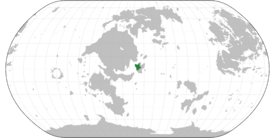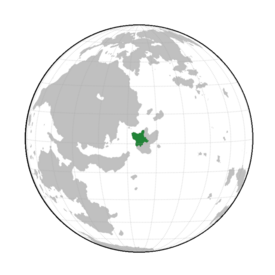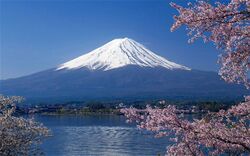Yeosan
Yeosan Autonomous Prefecture 麗山自治州(여산자치주) | |
|---|---|
|
Flag | |
| Motto: Preserve the People's Tradition (養民之傳; 양민지전) | |
| Anthem: Aegukga (愛國歌; 애국가) | |
 Yeosan on Eurth | |
 Yeosan in Alharu | |
| Capital | Seonggyeong 城京(성경) |
| Official languages | Yeosanese |
| Demonym(s) | Yeosanese |
| Government | Autonomous Prefecture |
• Prefectural Governor (知事; 지사) | Park Nam-Gi (朴南基; 박남기) |
| Legislature | Congress of Nations (FASR) |
| Establishment | |
• First humans arrive on the island | 30.000 BCE |
• Founding of the Honggi (紅旗; 홍기) | 8 CE |
• Conglomeration of the Baekjoksidae (百族時代; 백족시대) into the Daehongbuk (大紅北; 대홍북) by the Yellow Empire | 967 CE |
• Founding of Yeosan (麗山; 여산) | 1465 CE |
• Founding of Yeosan Empire (麗山帝國; 여산제국) | 1888 CE |
• Occupation by the Five Colour Empire (五色帝國; 오색제국) begins | 1905 CE |
• Incorporation into the FASR as an autonomous prefecture | 1929 CE |
| Population | |
• 2018 census | 48,677,838 |
| Currency | Yeosan Won Officially 圓(원) or Colloquially 円(원) (WON) |
| Time zone | UTC -3 |
| Date format | yyyy年mm月dd日 or yyyy년mm월dd일 |
| Driving side | right |
| Calling code | +88 |
| ISO 3166 code | YSN |
| Internet TLD | .ysn |
The Yeosan Autonomous Prefecture(Huang: 麗山自治州; Eonmun: 여산자치주), is an autonomous prefecture of the Federation of Alharun Socialist Republics (FASR) in equatorial Alharu. It is located on a 1,352,000 square kilometres (522,000 sq mi) island formed by volcanic activity about 82 million years ago. The nation itself encompasses approximately Template:Conver of the northwest portion of the island. Yeosan has a population of just over 48.5 million. Its capital is Seonggyeong (城京; 성경) and is resident to just over 8.5 million. The nation is known for its unique culture, which is largely grounded in that of the Huang Culture Sphere (黃文化圈; 황문화관) but has developed uniquely with Yeosan's isolation.
The Yeosanese are descendants of the first humans that came to the island around 30 thousand years ago. Not much is known about these peoples.
Etymology
The name Yeosan comes from the mountain at the centre of the island. The characters in the name, 麗山, translate literally to beautiful mountain. This name was first introduced by the founding of the Yeosan dynasty in 1465. It is thought that prehistoric groups of Yeosanese peoples on the island had given themselves a similar name using native vocabulary (아름다움뫼) before Huang contact, which inspired the naming of the new dynasty. This name was retained from the founding of the dynasty all the way to the modern day.
Geography

Yeosan is located on an island created by a volcano called Mount Baektu (白頭山; 백두산), meaning white headed mountain, approximately 82 million years ago. Its geography is quite drastic as its landscape ascends from sea level to around 5000 metres at the summit of the volcano.
The geographic location of the island near Alharu and the Yellow Empire caused much of the culture of the area to seep into native Yeosanese culture, to the point that Yeosan’s culture is largely similar to the Yellow Empire. This is reflective of other nations in the Huang Culture Sphere (黃文化圈; 황문화관). However, because of the nature of being an isolated island, Yeosan’s culture is still a unique part of greater Huang culture.
The climate in Yeosan varies wildly depending on where one is on the island due to its unique geography. In the north, east, and south near the sea, it is hot and humid with plenty of rainfall. Whereas in the west near the sea, the climate is more near to a Savanna, with sparse rains and typically warm temperatures. However, as one progresses inland the climate becomes harsher until the summit of the volcano is reached, which is sub-zero year-round.
Cities
The following is a selection of Yeosan’s most important cities:
| City | Population | Location | Description |
|---|---|---|---|
| Seonggyeong (城京; 성경) | 8.767.326 | West Yeosan | Capital and most populous city in Yeosan, serving as the administrative and economic centre. Home of the old central palace, Changangung (長安宮). |
| Gongju (公州; 공주) | 5.484.792 | South Yeosan | The second-largest city in Yeosan and it’s intellectual capital. Home to the most prestigious university in the nation, known as Yeosan University (麗山大學校; 여산대학교). |
| Haeju (海州; 해주) | 5.137.322 | Northeast Yeosan | Haeju is Yeosan’s shipping and fishing powerhouse. It is home to the largest fishing industry in the country, and all of Yeosan’s shipping companies are headquartered there. |
| Nongju (農州; 농주) | 3.856.915 | Central East Yeosan | Nongju is an agricultural powerhouse city and referred to commonly as Yeosan’s Bread Basket. |
| Gwangju (光州; 광주) | 3.734.677 | Northwest Yeosan | Gwangju is the industrial powerhouse of Yeosan and is home to a variety of factories for everything from televisions to aeroplanes. |
| Jeonsi (電市; 전시) | 1.867.334 | Central South Yeosan | The technology capital of Yeosan. A highly advanced technological city, its name literally means electric city. |
| Yeongsan (寧山; 영산) | 335.978 | Central West Yeosan | An alpine folk village situated upon the flanks of Mount Baektu, and a popular tourist attraction in Yeosan for its traditional culture, music, design, architecture, etc. |
History
The history of Yeosan is extensive, but there are several important events that summarise the nation’s past.
Prehistory
It is estimated that the first humans came to the island Yeosan is on today, arrived around 30 thousand years ago. Very little is known about the nature of these peoples, how they organised, what they build, ate, and did, etc. But it is presumed that they were hunter-gatherers who came to the island in search of food.
Early Civilisation
The first civilisation to be recorded in Yeosan’s history is the Honggi (紅旗; 홍기) in 8 CE. The name literally means red banner and is a name given by historians to the civilisation as the only surviving record of its existence come from outside Yeosan, and make reference only to the flag the civilisation bore. Although little survives of Honggi’s story, historians have been able to determine that Honggi was a powerful monarchy that united many factions that had previously been warring under one banner. This created an era of peace which allowed for greater advancement in the sciences. Honggi lasted roughly 700 years. This was due to a string of weak and incompetent kings who allowed the nation to fall into strife. After this, the nation collapsed into a hundred small territories dominated by clans who constantly fought each other. This period is known as Baekjoksidae (百族時代; 백족시대).
Yellow Empire

In 967 CE, the Yellow Empire expanded into the island and overran the fighting clans, finally putting a stop to years of turmoil. Under the Yellow Empire, Daehongbuk (大紅北; 대홍북) was founded. This began an extensive period of peace and started an era which allowed the arts and sciences to flourish. With them, the Yellow Empire brought Huang characters (黃字; 황자) to Yeosan. This replaced an archaic writing system that was highly regional and allowed people to finally be able to write and record history in an accurate and concise manner. The Daehongbuk marks the first time Yeosanese culture was allowed to develop and thrive in a manner never before seen. Many staples of Yeosan’s traditional culture were begun in this time. Though this era of peace and prosperity was long, it was brought to an end similarly to the Honggi. The King was weak and incompetent, which lead military generals to be worried about the future of the nation. So they rebelled and overthrew the King and had him executed, and then usurped the throne for themselves.
Establishment of Yeosan
After taking the throne in 1465 CE, the first King of Yeosan, Dangun (檀君; 단군), proclaimed a new nation, Yeosan (麗山; 여산). He chose this name as a tribute to the first peoples of Yeosan who were believed to have called themselves something of the same meaning, but in their native tongue—possibly something like 아름다움뫼. With the establishment of Yeosan, a new era began. One of no longer copying Huang culture, but refining it into something uniquely Yeosanese. Many of the cultural traditions Yeosanese observe today were refined in this time. Yeosan was not removed from the Yellow Empire in this time, however. Yeosan was part of the tributary system of the Yellow Empire during this time. Nonetheless, with strong and competent rulers, Yeosan flourished even greater than before in the arts and sciences. During this time, King Sejong the Great (世宗大王; 세종대왕) invented a native phonetic writing system for the Yeosanese called Eonmun (諺文; 언문). This allowed even uneducated peasant to read and write. However, the literati and upper classes opposed it, so the system was never standardised and although it gained wide use by the peasantry, it was never a viable replacement for Huang characters.
Establishment of the Empire
In 1888 CE, as the Yellow Empire lost control of itself, Yeosan saw this as a time to act. The acting King, Yihui (李㷩; 이희), cut Yeosan from the tributary system and declared himself the new Emperor of the Yeosan Empire. He created a new flag and promulgated it throughout the nation. This was a period of relative stability, and not much occurred in the fields of arts and sciences.
Occupation

In 1905 CE, the Five Colour Empire (五色帝國; 오색제국) occupied Yeosan. Because of previous involvement with the Yellow Empire, the Yeosanese did not reject the Five Colour Empire. This period marked a shift to modernity for Yeosan. Under the Daehongbuk, Yeosan, and Empire of Yeosan, much progress was made in arts and sciences, but Yeosan as a whole failed to industrialise. The Five Colour Empire brought railroads, roadways, electricity, factories, and all the cogs of industry to Yeosan. Along with this, the occupation brought about a standardisation of Eonmun and widespread access to education. This brought an orthographic shift in Yeosan as people began to stop writing in Huangmun (黃文; 황문) and began to write in Yeosanese vernacular using a mixed script of Huang characters and Eonmun. This era was transitional for Yeosan as it ascended the nation into the modern era, allowing for its development to today.
Joining the FASR
After the collapse of the 5 Colour Empire, Yeosan was thrown into chaos and slowly a liberation front gained power. In an effort to garner wider support, the Yeosan People's Party (麗山人民黨; 여산인민당) did not seek to destroy long-standing tradition or promote any sort of Cultural Revolution in Yeosan, but rather promoted the vernacular traditional culture of the people whilst fighting for their liberation. Because of this, they garnered wide support in the chaotic times post occupation and eventually took power. After a referendum in cooperation with the FASR, Yeosan was incorporated into the FASR in 1929. However, due to its cultural and linguistic differences, it was given the status of a self-governing prefecture. A new flag was introduced, based off of that of the Yeosan Empire. This was done in reference to the promotion of traditional culture. A red octagon was added, underlaying the traditional design, as an artistic reference to the liberation of the people by the People's Party and FASR. Because of the influence from the 5 Colour Empire and the FASR, Huang characters are still frequently used in writing mixed in with the native script, Eonmun. Yeosan's Chinese Character usage differs from other nations in that Yeosan prefers to use the Kangxi dictionary solely for its official character forms.
Politics
As an autonomous prefecture, all large government matters fall to the Federation of Alharun Socialist Republics (FASR). However, domestically, Yeosan is overseen by a Prefectural Governor who reports back to the central government of the FASR and oversees the semantic aspects of the prefectural government.
Economy
Yeosan's economy is a balance between industry and technology in urban centres and agriculture in rural areas. This concept was codified under the Five Colour Empire and refined until the modern day under the Sinchon Movement (新村運動; 신촌운동) to industrialise the nation.
Energy
Mount Baektu, located in the near centre of the island, is the main provider of Yeosan's energy via geothermal reactors taking advantage of the active volcano's lava. After the effects on the environment of dirty methods of power generation were observed in the years following industrialisation, Yeosan has, in recent years, turned to renewable energy and has a growing nuclear energy programme.
Infrastructure
Due to its rapid industrialisation, Yeosan's infrastructure is highly developed, and most major cities have multiple forms of public transport such as buses, trams, tube lines, etc. Along with this, the nation has two international airports, located in Seonggyeong and Gongju. There is also an extensive railway system, which was mostly constructed during the occupation. Yeosan is also notable for having free public Wi-Fi almost everywhere.
Demographics
The population of Yeosan is mostly concentrated in its urban centres like Seonggyeong and Gongju. Though, there is an even spread of the population outside of cities, who maintain the agricultural aspect of the nation's economy. Rising life expectancy makes the median age of the population increase from year to year. This demographic change is expected to put a heavy tax load on the younger generations in the foreseeable future.
Demographically, Yeosan is quite homogenous, with Yeosanese comprising a majority of the nation. A small minority groups of other Huang populations exist in various areas throughout the nation, due to its connections with the Yellow Empire, Five Colour Empire, and neighbouring Rhava. Non-Huang foreign minorities do exist in several of the larger cities in the nation, though they are very small and comprise very little of the population of Yeosan.
Language
The Yeosanese language (麗山語; 여산어) is a language isolate. It is the national language of Yeosan and is spoken by its nearly 50 million inhabitants. The history of the language is unclear, and modern Yeosanese linguists are unsure of its origins. Modern Yeosanese is written in a mixed script of Eonmun, the native phonetic writing system, and Huang characters, adopted during the Yellow Empire’s influence. Historically, Yeosanese was written using only Huang characters and methods to adapt them for both meaning and sound purposes in the language. Before that, however, people use an unknown highly regionalised proto-writing system that made it extremely difficult for people to communicate in writing and was never widely used.
Education
Education in Yeosan is considered to be crucial to living a fulfilling life. Thus, education is taken very seriously by families. Schooling in the nation is public, and students who attend schools in their city have free tuition. However, if a student wishes to board to another school (in secondary and tertiary levels) they may do so but will be expected to pay a small tuition fee equal to what taxpayers in the city pay. Students in Yeosan typically begin preschool between the ages of 3-4 and graduate university in their early 20s.
The Yeosanese education system is split into five levels: 3 years preschool (幼稚園; 유치원), 5 years primary school (初等學校; 초등학교), 3 years junior secondary school (下中學校, 하중학교), senior secondary school (上中學校, 상중학교), and 3 to 6 years university (大學校) depending upon degree. The preschool curriculum is focused on speaking, reading, and writing to prepare students for primary school. In primary school, students are taught broad knowledge regarding maths, the sciences, history, reading, writing, as well as music and the arts. Once students move into junior secondary, they begin to choose some of their courses and start the process of deciding what subject they want to study. In senior secondary school, students are allowed to select every course they desire to take to put them on the best path into the subject they want to study. By the end of senior secondary schooling, the student is taking subject specific courses to prepare them for university education.
At the end of their senior secondary schooling, all students must take two standardised tests. The first, titled the University Scholastic Ability Exam (大學修學能力試驗; 대학수학능력시험) is given to all students and taken across the nation at the same time. These exam dates are famous as it causes the entire nation to effectively shut down. Planes are grounded, and general business postponed so as not to distract exam takers. There have been several notable instances of police escort students to their testing centres, so they will not be late. The second test which students take immediately after the USAT is titled The ______ Ability Exam (____能力試驗; ____능력시험) and differs on subject. Each student will have different exams concerning whatever subject they will to go into. After these exams are complete they are sent to universities who then review them and then offer students spots in their universities according to their cumulative scores on the tests.
University education in Yeosan lasts anywhere from three to six years, depending both on the subject, and what degree a student wishes to obtain. Various notable degrees in recent years have been: Engineering, Architecture, Business, and several science related degrees. The most popular degree in the nation is a Bachelor's level, although recently Master's level degrees have been rising in popularity.
Culture
Yeosan has a unique culture that is grounded in Huang culture, but has been refined over a long period of time to be uniquely Yeosanese.
Architecture
Yeosan’s architecture is grounded in the principles of the Huang architecture culture, but has been refined into its own state over thousands of years. Yeosan has a unique structure, the Yeosanok (麗山屋; 여산옥), which is a traditional style of house in the country. Further, Yeosan’s architecture is fond of colours and patterns that get used on official buildings.
External links
- Yeosan (europans.com)
